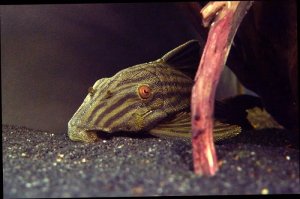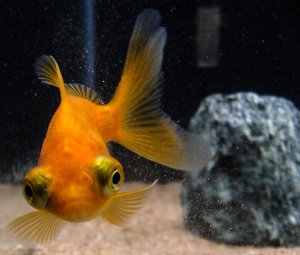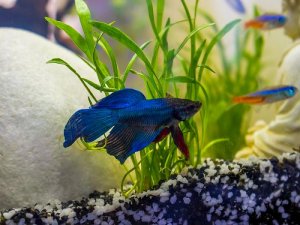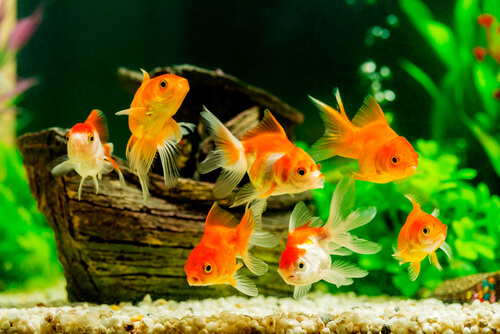
While recommended types of goldfish vary based on your requirements, either way, setting up a new tank involves a lot of different choices. Goldfish have been kept for thousands of years in China, and in that time a dizzying number of varieties developed. If you’re unsure about what varieties of goldfish would suit you best, this guide to both hardy goldfish varieties and fancy goldfish varieties will break down how they differ, so read on.
What Types Of Goldfish Are There?
When you enter your local aquatics store the amount of choice can be overwhelming. Are all types of goldfish the same? In fact, the different types of goldfish are technically the same species but have very different needs, depending on their history and characteristics.
History Of Fancy Goldfish Types:
All goldfish are descended from the wild Prussian carp that were initially kept for food in the ponds of Buddhist monks in China over 1000 years ago. Despite this, it was only in the most recent 200-400 of history that they were traded with other countries.
After indoor ponds developed, goldfish could be selectively bred to have features that would have hindered them in the wild. Early fancy goldfish varieties such as the fantail and black moor developed as a result of this. Read on for 10 recommended types of goldfish for all ability levels!
10 Recommended Different Types Of Goldfish:
1. Comet Goldfish
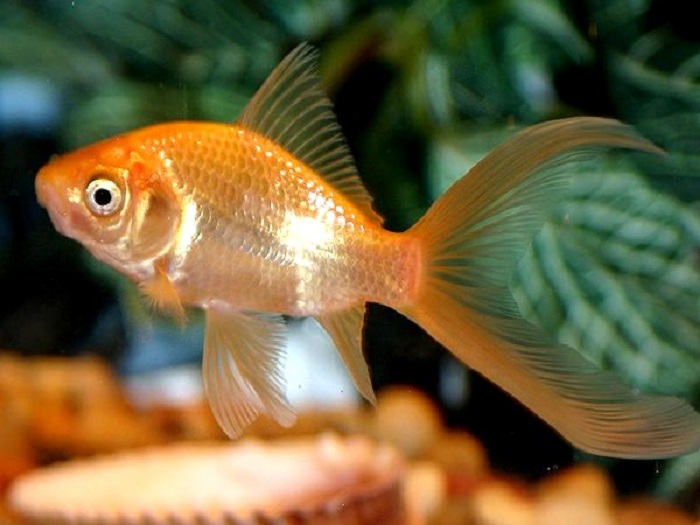
The comet goldfish is one of the most common varieties of goldfish and often used to be won as a fairground prize. Comet goldfish can live up to 20 years in captivity although 10-15 is more common. They can also reach up to 12 inches or 30 centimeters in length when they are given ample room to grow.
Origins:
America in the 1800s – this fish was bred from the common goldfish by Hugo Mullert.
Appearance:
Comet goldfish have a flat body and a deep, forked tail, coming in gold, red, yellow, orange, blue, black, or bicolored varieties, including the Sarasa comet, a combination of red and white developed in Japan.
Requirements:
- Filter flow rate: 10x tank capacity
- Tank size: min 40 gallons/151 liters with 20 gallons/76 liters per additional fish. These are really active goldfish.
- Temperature: 60-74 F or 18-23 C
- pH: pH 7-8
- Ammonia and nitrates: zero
- Feeding: sinking pellets, vegetables, and live or frozen protein, which is especially important for helping them grow.
- Tankmates and environment: A planted tank with plenty of places to explore and hide is best for these curious fish that need lots of stimulation.
Temperament:
Active and curious
Difficulty level:
Beginner
2. Black Moor Goldfish
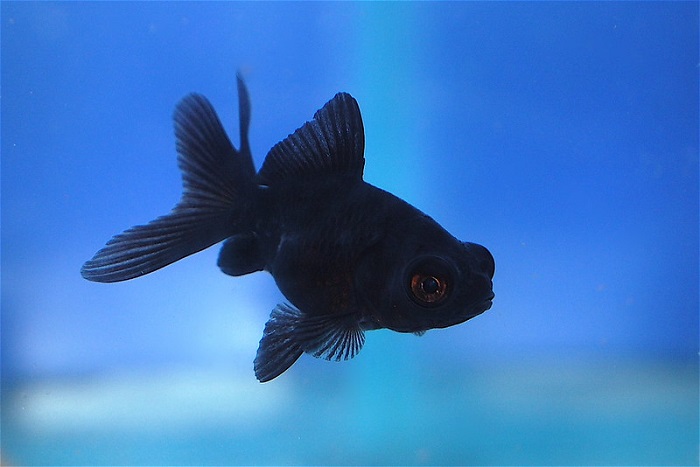
With their midnight black color, these little fish often stand out in pet stores! They can live from 10-15 years and grow to approximately 8 inches or 15 cm.
Origins:
China
Appearance:
A dark velvety black body and telescopic eyes. The body is egg-shaped though not as distinctly as some varieties such as the ranchu. Occasionally, you will see bronze scales on the fish’s underbelly.
Requirements:
- Filter flow rate: 4x tank capacity
- Tank size: min 30 gallons/114 liters with 10 gallons/38 liters per additional fish. Black moors prefer groups of 5 or 6
- Temperature: 65-74 F/18-23 C
- Ph: pH 7-8
- Ammonia and nitrates: zero
- Feeding: sinking pellets, vegetables, and frozen protein like daphnia or tubifex worms only
- Tankmates and environment: Black moors are happiest with their own kind in a planted tank, or with invertebrates like snails.
Temperament:
Gentle, calm, shy
Difficulty level:
Beginner-intermediate
3. Shubunkin Goldfish
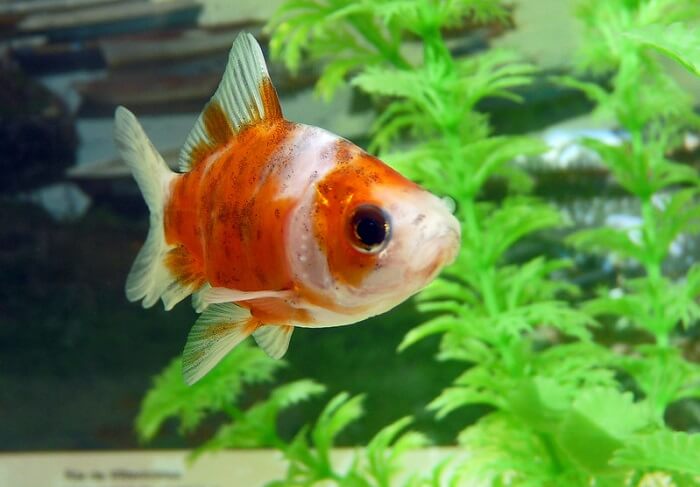
The shubunkin describes not one but three sub-varieties of goldfish first developed in Japan. These include the London shubunkin, Bristol shubunkin, and American/Japanese shubunkin. As hardy fish, the shubunkin can live 15-20 years and grow up to 12 inches or 30 cm!
Origins:
Japan
Appearance:
The shubunkin goldfish can be both single and double-tailed. Its main color is calico, though some shubunkins have more markings of one color or another. Of the three, London shubunkins have the roundest bodies, and Bristol shubunkins the flattest.
Requirements:
- Filter flow rate: ideally 10x tank capacity
- Tank size: minimum 40 gallons/151 liters to begin with an extra 20 gallons/76 liters per additional fish
- Temperature: 60-74 F or 15-23 C
- Ph: pH 7-8
- Ammonia and nitrates: 0
- Food: pellets, frozen and live protein, and vegetables
- Tankmates and environment: each subtype is best kept with their own kind as they have slightly different body shapes. However, like many goldfish varieties, shubunkins are good for pairing with other tankmates that aren’t goldfish.
Temperament:
Active but peaceful
Difficulty level:
Beginner
4. Fantail Goldfish
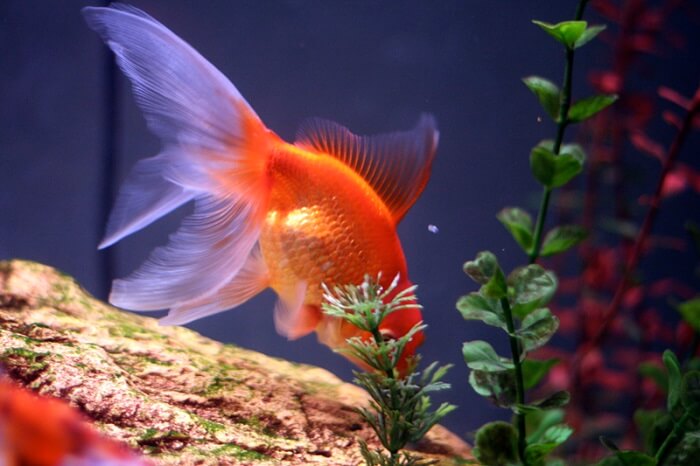
The fantail is a relatively hardy fancy goldfish and can live from 10-20 years. Its egg-shaped body does make it a slower swimmer than hardy goldfish, but if you want a beginner fancy goldfish this is a great one to go for. They can grow up to 8 inches or 20 cm.
Origins:
China
Appearance:
The fantail usually has a plain gold color and an egg-shaped body with a double tail in the shape of a fan. This unique trait has existed since the Song Dynasty in China. It can also be red, orange, yellow, blue, black, silver, and bi or tri-colored.
Requirements:
- Flow rate: 4x tank capacity
- Tank size: min 30 gallons/114 liters to start and an additional 10 gallons/38 liters per fish
- Temperature: 65-74 F/18-23 C
- pH: 7-8
- Ammonia and nitrates: 0
- Food: sinking pellets, vegetables, and frozen protein only
- Tankmates and environment: The fantail is best paired with other fantails or similar egg-shaped goldfish. A planted tank is always a bonus, too.
Temperament:
Curious, yet lower activity than hardy goldfish
Difficulty level:
Beginner-intermediate
5. Common Goldfish
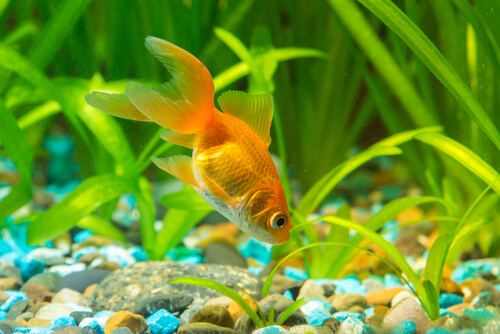
The common goldfish can be kept in either a pond or a tank and can grow up to 12 inches or 30 centimeters. They generally live 10-20 years but can live longer. In fact, one of the oldest goldfish, Tish, was 47 years old when he died in North Yorkshire, UK.
Origins:
China
Appearance:
The common goldfish is a flat-bodied goldfish that is typically a bright orange color. They can alternatively come in black, red, and yellow varieties and though relatively plain, they make great pets full of character.
Requirements:
- Flow rate; min 10x tank capacity
- Tank size: like other active flat-bodied goldfish, they like a minimum of 40 gallons/151 liters to begin with, plus an extra 20 gallons/76 liters per extra fish
- Temperature: approx 60-74 F 15-23 C but can survive as low as 50 F/10 C
- Ph: 7-8
- Ammonia and nitrates: 0
- Food: live and frozen protein, pellets, and vegetables
- Tankmates and environment: best paired with comets, other common goldfish, or long bodied shubunkins like the Bristol shubunkin. They enjoy lots of places to hide and explore.
Temperament:
Lively and energetic yet peaceful. These vibrant goldfish are some of the hardiest, and their behavior tends to change before death, so it’s easy to see if your fish are healthy.
Difficulty level:
Beginner
6. Telescopic Goldfish
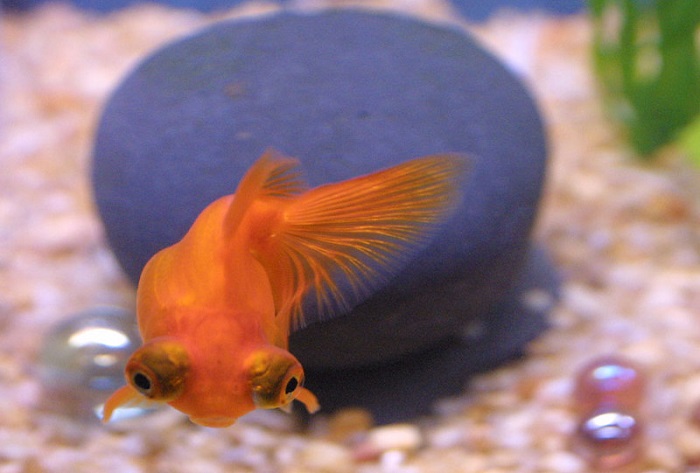
The telescopic goldfish resembles the black moor but comes in many more colors, and the mutation that causes protruding eyes appeared in the 1700s, and doesn’t harm them. In fact, the telescope eye goldfish can live 10-15 years if cared for well and grow up to 6 inches or 15 cm.
Origins:
China
Appearance:
With an egg-shaped body and striking eyes, this fish can come in calico, red, gold, orange, blue, silver, and bi and tri-colored variants. It generally has a double tail.
Requirements:
- Filter flow rate: minimum 4x tank capacity
- Tank size 30 gallons/114 liters to begin with and an extra 10 gallons.38 liters per fish
- Temperature 65-74/18-23 C
- Ph: pH 7-8
- Ammonia and nitrates 0
- Feeding: Only feed frozen protein – they can’t see well enough to catch live protein. Otherwise, feed pellets and vegetable matter as well.
- Tankmates and environment: Their poor eyesight means they can be outcompeted for food, so keep them with other poorly-sighted fish like the bubble-eye goldfish.
Temperament:
Easygoing, social and curious
Difficulty level:
Intermediate
7. Lionhead Goldfish
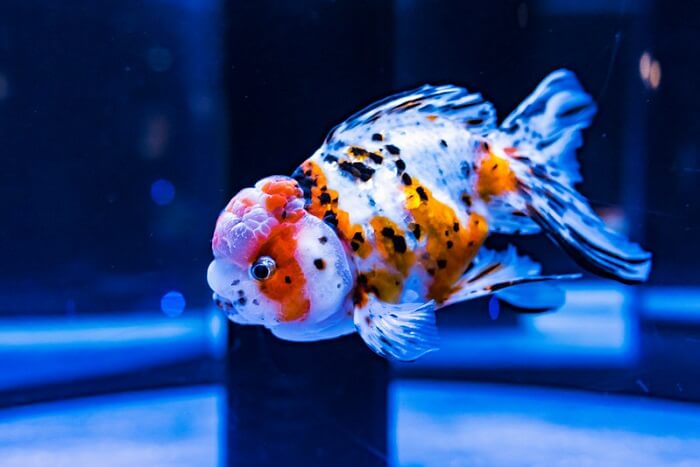
This sensitive goldfish variety shares a body shape and hooded growth with the ranchu goldfish or oranda goldfish. Nevertheless, they can still live up to 10-15 years if well cared for and grow up to 6-8 inches/15-20 cm.
Origins:
China
Appearance:
With a growth of undifferentiated cells that form the raspberry-shaped ‘wen’ on its head, it is named after the slight resemblance in the silhouette of its head to the Chinese lion dog.
It has a double tail and egg-shaped body and can come in red, white, black, orange, yellow, gold, and a red-white bicolored variety called the red cap.
Requirements:
- Filter flow rate: minimum 4x tank capacity
- Tank size: min 30 gallons/114 liters – with an extra 10 gallons/38 liters per extra fish
- Temperature: 65-74 F/18-23 C
- pH: 7-8
- Ammonia and nitrates: 0
- Feeding: frozen protein, pellets, and vegetable matter only. Protein can encourage wen overgrowth in any hooded goldfish, which requires a specialist aquatic vet for surgery if this happens.
- Tankmates and environment: best paired with other hooded goldfish like the ranchu or oranda, or with non-goldfish tankmates such as snails.
Temperament:
Peaceful, explorative
Difficulty Level:
Experienced.
8. Celestial-Eye Goldfish
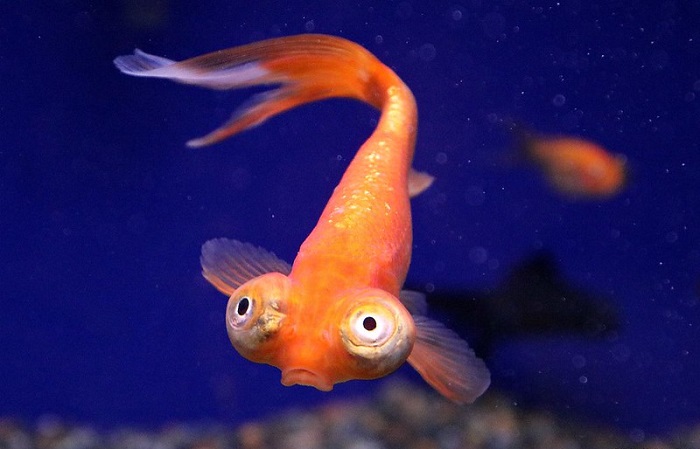
The celestial-eye goldfish is similar to the telescopic goldfish except the eyes themselves are turned upwards. First seen in the 1700s, there is debate whether the first true celestial eye goldfish appeared in China or in Korea. They generally live 10-15 years and grow up to 5-8 inches/12-20 cm.
Origins:
China or possibly Korea
Requirements:
- Filter flow rate: min 4x tank capacity
- Tank size: min 30 gallons/114 liters with an additional 10 gallons/38 liters per extra fish
- Temperature: 65-74 F/18-23 C
- pH: 7-8
- Ammonia and nitrates: 0
- Feeding: only feed frozen protein vegetables, and sinking pellets. This fish can’t always find food floating on the surface of the water.
- Tankmates and Environment: best paired with the bubble-eye, or telescopic goldfish. Non-goldfish tankmates can also be added- fish like zebra danios have similar diets but keep themselves to themselves, so both species coexist.
Temperament:
Gentle, calm
Difficulty level:
Experienced
9. Bubble-Eye Goldfish
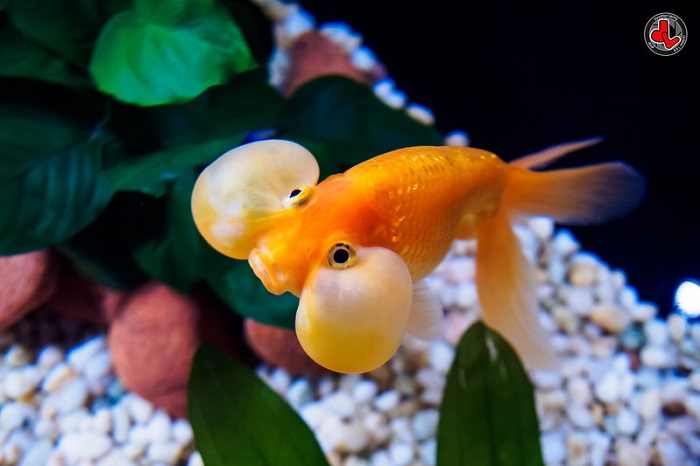
These are one of the most unusual and dramatic goldfish varieties on this list! The bubble-eye goldfish originated from the toadhead goldfish and is the result of many generations of selective breeding, making a fish very different from wild carp. They live from 10-15 years and grow to a maximum of 5 inches/12cm.
Appearance:
With large fluid-filled sacs under their eyes, there is no missing the bubble eye goldfish. They can come in a variety of colors including calico, and this can lead to really interesting markings on the eye sacs, too.
Origins:
China
Requirements:
- Filter flow rate: 4x tank capacity.
- Tank size: min 30 gallons/114 liters and an extra 10 gallons/38 liters per fish
- Temperature: 65-74 F/18-23 C
- pH: 7-8
- Ammonia and nitrates: 0
- Feeding: frozen protein, sinking pellets and vegetable matter only. If your goldfish isn’t eating, amongst other reasons they sometimes struggle to access food due to their eye sacs.
- Tankmates and environment: These sensitive, shy fish benefit from similar tankmates. Ideally, these fish get on best with their own kind, celestial-eye, or telescopic goldfish.
Temperament:
Quiet, sensitive
Difficulty level:
Experienced
10. Pompom Goldfish
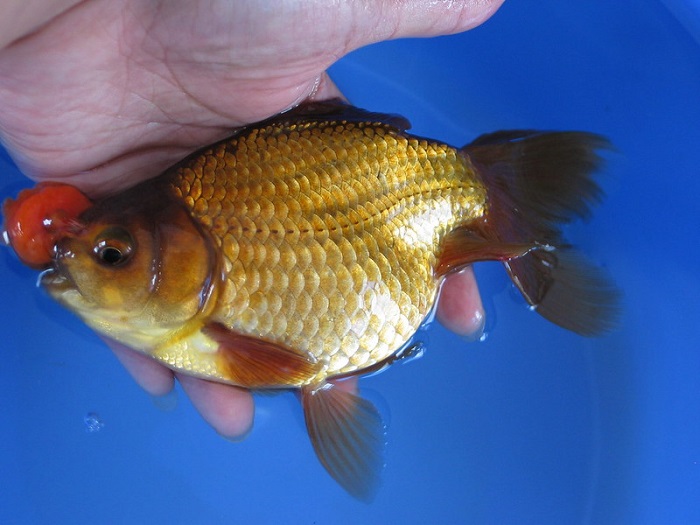
This is a lesser-known but extremely striking fancy goldfish that gets its name from colorful protuberances on its nose that look like frills or pompoms.
The pompom has somewhat fallen out of fashion since it first appeared in china in the 1800s, when Shanghai supplied a demand based on its intense popularity in the west. It is similar to the lionhead in that it lives roughly 10-15 years and grows from 5-8 inches/12-20cm.
Origins:
China
Appearance:
Like the ranchu, this fish can come with or without a dorsal fin, which affects how well the fish can balance in the water. The pom-pom characteristic itself is a name based on fleshy growths on the fish’s face. Pom-pom goldfish come in red, yellow, orange, black, blue, and calico. They can be metallic or nacreous and often the growths are a different color from the main body.
Requirements:
- Filter flow rate: min 4x tank capacity
- Tank size: min 30 gallons/114 liters with an extra 10 gallons/38 liters per fish
- Temperature: 65-74 F/18-23 C
- pH: 7-8
- Ammonia and nitrates: 0
- Feeding: frozen protein, sinking pellets and vegetable matter
- Tankmates and environment: best paired with other egg-shaped goldfish. The oranda, ranchu, and lionhead work particularly well.
Temperament:
Gentle and social
Difficulty Level:
Advanced
Final Thoughts
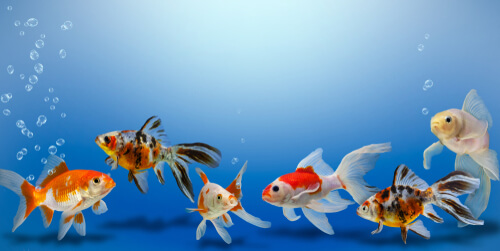
It may be overwhelming to see the different varieties of goldfish on offer when you walk into a pet shop, but hopefully, this guide should break them down. Remember, all goldfish varieties are different and have unique needs!
From the humble Prussian carp, it is amazing to see how many different kinds of goldfish there are, varying in everything from color and shape to temperament.


